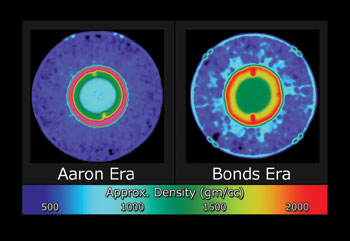
Looking Inside Baseballs for Home Run Secrets
The players themselves may not be the only factor in the ever-increasing tendency for home run records to be knocked out of the park. Recent computed tomography (CT) studies have found changes in the balls used by Major League Baseball (MLB) that may clarify some of the surprising statistical leaps and decrease the statistics’ validity in comparing today’s athletic achievements with those of the past.

Scientists compared baseballs used during Hank Aaron’s career with those used by Barry Bonds, the most recent home run record holder. The size and density of the core material has increased, subsequently improving the distance that Barry Bonds-era baseballs travel.
Employing the same methods used to detect oil in rock core samples, scientists from Universal Medical Systems Inc. of Cleveland and from the Center for Quantitative Imaging at Pennsylvania State University in University Park used a CT scanner to take cross-sectional images of major league baseballs produced from 1915 to 2007. The noncontact method uses differences in x-ray absorption to create contrast and reveal density. The researchers used multi- and single-slice Philips CT scanners that were calibrated and tuned specifically to the size and material content of baseballs.
They found that the density of the materials used to make official major league baseballs has increased several times throughout history. For example, the core density increased rapidly after Rawlings became the exclusive supplier for baseballs in 1977, the year after Hank Aaron retired. Until recently, Aaron held the MLB’s career home run record. Because there is a direct relationship between increases in density and a ball’s capacity to travel greater distances, the league’s total home runs spiked by 63 percent, from 2235 runs in 1976 to 3644 in 1977.
In addition, scientists found that the league replaced the traditional cork center with an enlarged rubberized core, known as a pill. Pure cork is used in all minor league baseballs. In 2000, the MLB removed the historic words “cushioned cork center” from every baseball. The increased size and density of the pill has improved the hit distance by approximately 30 feet since 1977.
This is good news for baseball purists hoping to defend the reputations of the game’s great patriarchs. The study suggests that the newcomers may not be better athletes, they just use better baseballs.
Published: September 2007